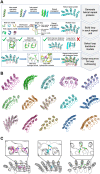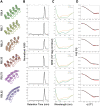This is a preprint.
De novo design of buttressed loops for sculpting protein functions
- PMID: 37662224
- PMCID: PMC10473674
- DOI: 10.1101/2023.08.22.554384
De novo design of buttressed loops for sculpting protein functions
Update in
-
De novo design of buttressed loops for sculpting protein functions.Nat Chem Biol. 2024 Aug;20(8):974-980. doi: 10.1038/s41589-024-01632-2. Epub 2024 May 30. Nat Chem Biol. 2024. PMID: 38816644 Free PMC article.
Abstract
In natural proteins, structured loops play central roles in molecular recognition, signal transduction and enzyme catalysis. However, because of the intrinsic flexibility and irregularity of loop regions, organizing multiple structured loops at protein functional sites has been very difficult to achieve by de novo protein design. Here we describe a solution to this problem that generates structured loops buttressed by extensive hydrogen bonding interactions with two neighboring loops and with secondary structure elements. We use this approach to design tandem repeat proteins with buttressed loops ranging from 9 to 14 residues in length. Experimental characterization shows the designs are folded and monodisperse, highly soluble, and thermally stable. Crystal structures are in close agreement with the computational design models, with the loops structured and buttressed by their neighbors as designed. We demonstrate the functionality afforded by loop buttressing by designing and characterizing binders for extended peptides in which the loops form one side of an extended binding pocket. The ability to design multiple structured loops should contribute quite generally to efforts to design new protein functions.
Figures




References
-
- Pluckthun A. Designed ankyrin repeat proteins (DARPins): binding proteins for research, diagnostics, and therapy. Annu Rev Pharmacol Toxicol 55, 489–511 (2015). - PubMed
Publication types
Grants and funding
LinkOut - more resources
Full Text Sources
